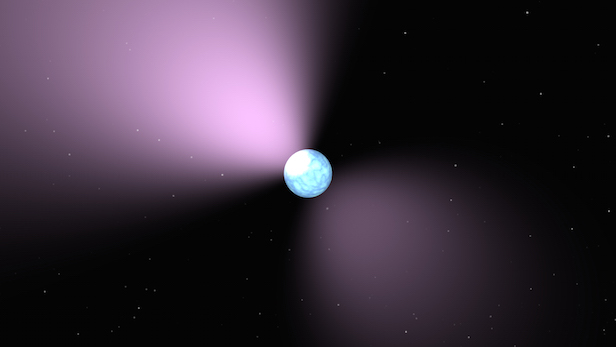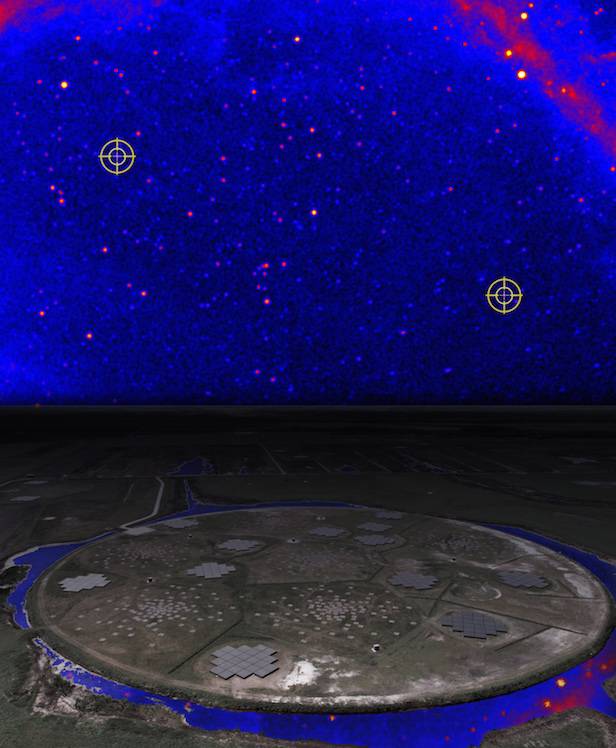Second fastest-spinning pulsar discovered
This pulsar is devouring matter from its companion star to power its rapid rotation

Pulsars are dense remnants of massive exploded stars, and are part of a class of stars called neutron stars. Image credit: SA/JPL-Caltech
The Low Frequency Array (LOFAR) radio telescope in the Netherlands made follow-up observations of multiple unknown high-energy objects which were outlined by NASA’s Fermi Gamma-ray Space Telescope. This led to the discovery of a pulsar with an incredible spin rate of 707 rotations per second, which makes it the second fastest known pulsar.
A pulsar arises after a massive star explodes in a spectacle supernova, leaving behind a small, dense core. This stellar core, also known as a neutron star, usually has a mass similar to about twice that of our Sun, packed into the size of a star about the size of Washington, D.C., United States. This energetic star emits energy across a range of wavelengths, including radio waves, visible light, X-rays and gamma rays. These waves then make their way to Earth, where the astronomers observe these regular bursts of energy.
“Roughly a third of the gamma-ray sources found by Fermi have not been detected at other wavelengths,” said Elizabeth Ferrara, a member of NASA’s Goddard Space Center in Greenbelt, Maryland. “Many of these unassociated sources may be pulsars, but we often need follow-up from radio observatories to detect the pulses and prove it. There’s a real synergy across the extreme ends of the electromagnetic spectrum in hunting for them.”
This brisk pulsar, named PSR J0952-0607 (or J0952 for short), has now been classified as a millisecond pulsar. It is located between 3,200 and 5,700 light years away in the constellation of Sextans. It is believed to have a mass of around 1.4-times the mass of the Sun, and has its own companion that orbits the pulsar once every 6.4 hours. This companion is in the process of being engulfed by J0952, and its mass is now only twenty times the mass of Jupiter.

LOFAR observed both J0952 (right) and J1552+5437 (left) using a network of thousands of linked radio antennas. Image credit: NASA/DOE/Fermi LAT Collaboration and ASTEON.
It is believed that because of this absorption of matter from its companion, the pulsar has been able to reach speeds of 707 rotations per second – or more than 42,000 revolutions per minute (rpm). This makes it the second fastest known pulsar, with the first being PSR J1748-2446ad, which reaches almost 43,000 rpm. There was also a second pulsar discovered along with J0952, which was named PSR J1552+5437, and makes 412 rotations per second.
“LOFAR picked up pulses from J0952 at radio frequencies around 135MHz, which is about 45 per cent lower than the lowest frequencies of conventional radio searches,” said Cees Bassa at the Netherlands Institute for Radio Astronomy (ASTRON). “We found that J0952 has a steep radio spectrum, which means its radio pulses fade out very quickly at higher frequencies. It would have been a challenge to find it without LOFAR.”
Theorists state that pulsars can reach a maximum speed of 72,000 rpm before they are ripped apart. The fastest spin we have seen is 43,000 rpm, which is just 60 per cent the theoretical maximum. Unfortunately, this is a huge gap between theory and observation, but this is most probably due to not being able to detect such fast rotators.
Keep up to date with the latest space news in All About Space – available every month for just £4.99. Alternatively you can subscribe here for a fraction of the price!




